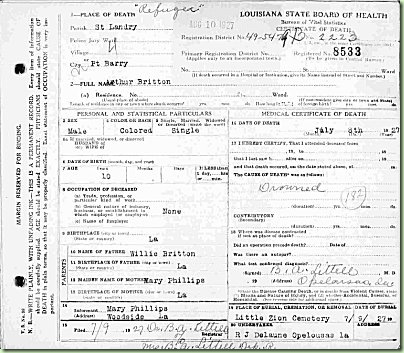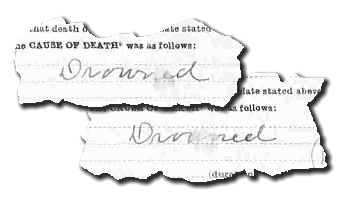In memory of those who perished in the flooding on this day in 1927, I’m republishing this article from 23 September 2008.
Last week I indexed a batch of Louisiana Death certificates. Soon I was so drawn into these people's lives, that it took all week to get one batch done.
I started on the first certificate. Cause of death? Drowning. How sad. How old was this person? A ten year old boy. Wow; that is sad. Why did someone write "refugee" at the top?

Next certificate. Also "refugee" at the top. Cause of death? Also drowning!
Wait a minute. Duplicate certificate? No. This name was North Hudson. I see he’s only five years old. Next I see he is his father's name sake.
Same date? Yes, 8 July 1927. Both in Port Barre, St. Landry Parish; wow. Opelousas is crossed out and Porte Barre written in. Wonder what happened.
Third and fourth certificates. Also refugees who drowned on 8 July 1927. Both named Hudson. North Hudson was here again, as informant. Does that mean he had to identify family member’s bodies?

Fifth, sixth, and seventh certificates are all children of Delphine Thornton, ages 13, 9 and 5. All 8 July 1927 in Port Barre. Oh, my goodness. She lost three children in whatever happened.
What did happen? It didn't take very long before Google uncovered the Great Flood of 1927. The Mississippi had overflowed her banks during the spring runoff.
The two photos, below, show Kerr's Drug Store in Port Barre early in the flooding and 13 days later.
Displaced "refugees" were evacuated to neighboring communities.
I'm still unclear of all the goings on, but the floodwaters seem to have lasted for months. On 8 July 1927 I think the levee protecting Port Barre failed. It fell to the medical examiner in Opelousas to perform the terrible last reuniting of lost family members. I found myself feeling awkward, standing in the back, an unbidden guest, witnessing this pervasively private moment.
Then I thought that perhaps, if caring members of these families ever come looking for them, my indexing will bring them to this very same spot, let them see what I am seeing. I will have quietly slipped out the back, letting loving family unite again across time. And grieve. And remember.





We have no idea the toll of human suffering in natural disastors now and long ago.
ReplyDeleteJohn Barry wrote a best selling book in 1997 about this tragedy, "Rising Tide: The Great Flood of 1927 and how it changed America." I commend the book and others he has written.
ReplyDeleteFrom Library Journal:
In the spring of 1927, America witnessed perhaps its greatest natural disaster: a flood that profoundly changed race relations, government, and society in the Mississippi River valley region. Barry presents here a fascinating social history of the effects of the massive flood. More than 30 feet of water stood over land inhabited by nearly one million people. Almost 300,000 African Americans were forced to live in refugee camps for months. Many people, both black and white, left the land and never returned. Using an impressive array of primary and secondary sources, Barry clearly traces and analyzes how the changes produced by the flood in the lower South came into conflict and ultimately destroyed the old planter aristocracy, accelerated black migration to the North, and foreshadowed federal government intervention in the region's social and economic life during the New Deal. His well-written work supplants Pete Daniel's Deep'n as It Come: The 1927 Mississippi Flood (1977) as the standard work on the subject.